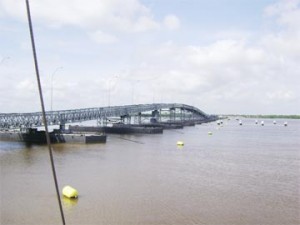The shareholders agreement for the Berbice Bridge Company Incorpo-rated (BBCI) has to be scrapped and replaced by one which reflects proportionality in investment, according to former Auditor General Anand Goolsarran.
Writing in his accountability column in today’s Stabroek News, Goolsarran addressed the standoff between the government and the BBCI over the planned lowering of the tolls to commuters. BBCI had thus far resisted the government offer for a subsidy on present tolls and instead wants either a 55% increase in tolls or an extension of the concession period from 21 to 50 years.
Goolsarran said that the alternative proposal for an extension of the concession agreement is worth considering. However, he said that more than doubling the life of the agreement is unlikely to find favour with the Govern-ment. He said that an extension by 5-10 years may be more appropriate but subject to two conditionalities.
“The first is that the financing of the Bridge’s operations is in urgent need of restructuring so as to reduce costs and hence to provide the much-needed relief to commuters. At the moment, the BBCI is too highly geared, meaning that there is too much debt (as opposed to equity) which has to be serviced from the revenues of the Bridge. Second, the Government must be allowed to have a say at the level of BBCI board that is commensurate with its investment. The current Shareholders’ Agreement therefore needs to be scrapped and replaced by a one that reflects proportionality in investment”, he asserted.


Noting that various figures have been quoted for the cost of construction of the Berbice River Bridge ranging from US$38 million to US$41 million, Goolsarran said that this does not include the cost of the feasibility study of US$1 million as well as the US$11 million outlay on the construction of the access road on both sides of the river, financed by the IDB as a loan to the Government of Guyana. Further, some $85 million was expended by government holding company NICIL to meet various costs associated with the Bridge. Using the lower figure for the direct construction cost of the Bridge, Goolsarran said that the total project cost works out to US$50.410 million.
The direct construction cost, equivalent to $7.874 billion, was funded from a mix of financing comprising debt of $6.484 billion, and equity of $1.350 billion. Goolsarran said that this gives a debt to equity ratio of 83:17.
“The BBCI is highly geared and therefore interest charges are an important consideration in determining the financial viability of the company. We know that the company is yet to pay dividends to its shareholders, including the cash-strapped National Insurance Scheme. The company is reported to have accumulated losses totalling $1.5 billion as at the end of last year and could face insolvency. Was the company not aware from the very inception that the present financing arrangement will pose significant challenges in terms of the financial viability? Or, was BBCI hoping that, given its monopoly status, it could increase tolls to meet shortfalls in revenue vis-à-vis expenditure?”, Goolsarran queried.
From the Government’s perspective, he said that the NIS has become the victim of collateral damage from a poorly thought out financing arrangement. He noted that the NIS has invested $80 million in ordinary shares and $950 million in preferred shares out of a total shareholding of $1.350 billion.
 “NIS therefore owns 76% of the total shareholding. Yet the Government has little say at the level of BBCI board because control is skewed in favour of two private investors owning a mere 15% of the total shareholding. The concern is even greater when one considers that the Government has contributed an additional $2.571 billion through the IDB loan and the expenditure incurred by NICIL. The whole arrangement involving the mix of financing and control over the composition of the BBCI board is therefore seriously flawed”, Goolsarran declared.
“NIS therefore owns 76% of the total shareholding. Yet the Government has little say at the level of BBCI board because control is skewed in favour of two private investors owning a mere 15% of the total shareholding. The concern is even greater when one considers that the Government has contributed an additional $2.571 billion through the IDB loan and the expenditure incurred by NICIL. The whole arrangement involving the mix of financing and control over the composition of the BBCI board is therefore seriously flawed”, Goolsarran declared.
Meanwhile, economist and Sunday Stabroek columnist Rawle Lucas in his September 6 contribution stated that a re-assessment of the deal is needed and called for more data to be released.
Market failure
“One has to understand the strategic intention of the PPP/C government in deciding to build the bridge. It is hard to imagine that the PPP/C would build a bridge with the money of taxpayers and then turn around and expect that they would be the ones carrying the burden of the investment for the private investors. But that is what is happening. The bridge as a monopoly is a classic case of market failure which was not addressed fully by the PPP/C government”, he charged.
He said that taxpayers having agreed to pay for the building of the bridge find that the market is being stage-managed to their exclusion with the extremely high tolls.
“What is worse, the equity investors do not want the new government to correct the market failure on behalf of those taxpayers bearing the burden of the tolls. This attitude is surprising especially since from all indications the returns to bond holders would be secured by the subsidy proposed by the new government”, he noted.
He argued that it is odd that the taxpayers are the ones who built the bridge and are now being asked to carry the burden of its operation.
“The way around the conundrum is to re-evaluate the strategic intentions of the PPP/C government against the cost and benefits of the project to both the taxpayers and the private investors. This could be done with the use of a series of metrics which could tell Guyanese whether or not the government pursued the best deal for the taxpayers of Guyana … They are the internal rate of return of the project, the return on equity of the project, the annual debt-service coverage ratio, the loan life debt-service coverage ratio, and the net present value of subsidies”, he said.
Lucas stated that the internal rate of return would indicate the return on the project regardless of the financing structure. By assessing that figure, he said that Guyanese would know if the project was seen as feasible or not at the time that the decision was made to go ahead with it. He noted that according to disclosures of the former PPP/C government, the private investors were expected to earn at least 12 per cent on their meagre equity investment.
“Guyanese need more information on the (return on equity), a measure of the profitability of the project for those persons who were expected to own the project and receive dividends from it. It would offer an idea of what motivated the private investors to put just five per cent of the equity but control 100 per cent of the profits made from it. Equally valuable would be an awareness of the annual debt-service coverage ratio of the company. This metric would enable Guyanese to determine if the project company has the ability to repay debt”, Lucas said.
He declared that the data on the investment must be made fully available if a reasonable outcome about the bridge is to be reached.
Takeover
Almost two years ago on his blog, analyst Christopher Ram had raised concerns about the viability of the bridge.
He had posited that given likely liquidity problems, the best option for the BBCI is a government takeover.
Ram had argued then that since its opening in December 2008, the bridge has “spectacularly failed to deliver the promises” made by former President Bharrat Jagdeo and head of government holding company, NICIL, Winston Brassington about reasonable tolls, profitability and the payment of preference dividends annually. He said, the waiver of dividends to the state is required to lend an appearance of viability to the bridge company.
Ram had argued that even under these favoured conditions and concessions and waivers, the company will face liquidity issues as bond and other payments become due.
Noting that the financing structure for the Bridge Company is Brassington’s, Ram said that even before the bridge was built, many had challenged his projections as being far too optimistic. Ram said it took no more than a few years before it became reality that the financial structure of the Bridge Company was weak. Ram added that had $500 million-plus dividends not been waived, BBCI would have been “unable to meet its obligations and would be in a serious overdraft position.”
He had said that his fear was that not only will every effort be made by Brassington to have the country continue to give up its entitlement to the preference dividends of $104 million annually but that the government could also lose most if not all of the $950 million invested in preference shares. The NIS he said could also lose out on its $80 million equity and possibly a portion of the approximately $1,500 million in its loan investment in the company.
With its high borrowings, Ram said that liquidity dangers for the Bridge Company are never far away.
Ram had also commented on the structure of the board of BBCI. He noted for its 70.3% of the total issued shares in the company, the government is entitled to have only one director while the Ramroop group has two directors with its 12% shareholding and the Hand-in-Hand group for its 3% holding holds the chairmanship of the board. The NIS which owns 20% of the company’s equity capital or 6% of its total capital had one representative.
Another large investor in the company is the New Building Society ($1,870 million) but it has no representation on the Board. This asymmetry seems typical of Brassington’s concept of public-private sector partnership, Ram had argued.




